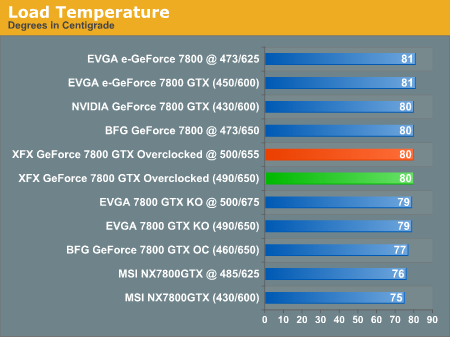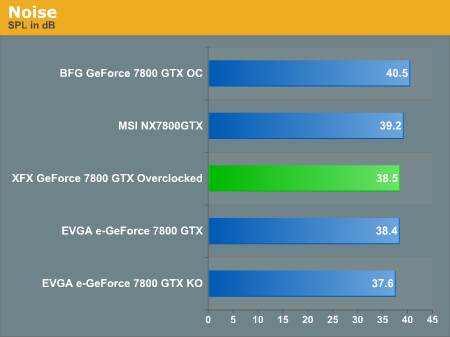Power, Heat and Noise
Power
When testing the power usage of this card, we found that it wasn't nearly as power-hungry as the EVGA e-GeForce 7800 GTX KO. This is worth mentioning because of the match in performance between the two. As you can see, at the factory clock of 490MHz and 1.3GHz, we measured the power load at 274 watts; the same as the BFG GeForce 7800 GTX OC out of the box. When we overclocked the card to 500MHz and 1.32HGz, we get a power load of 277 watts, the same as the overclocked MSI NX7800 GTX. For reference, the power load was 148 watts while the system was idle.

Keep in mind that the way we test the power usage of these cards is by measuring the wattage of the entire system at the wall outlet, then comparing the differences. These numbers don't represent the exact wattage of the graphics cards. Rather, they are simply meant to give us a general idea of how much power a card generates at different speeds.
Heat

As it turns out, this card did run a bit on the hot side. It ran slightly hotter than the EVGA e-GeForce 7800 GTX KO, though it was only a degree warmer. 80 C puts it in a tie for hottest card with the non-KO eVGA and the overclocked BFG 7800 GTX. We suspected that it would generate more heat in relation to the other cards because of the higher overclock, but it wasn't really much worse. It may not do as well as the EVGA KO in hotter climates because of the unmodified heat sink, but the single degree difference is tough to call significant. MSI of course continues to lead the temperature category, though again a 2 degrees C difference isn't huge. For reference, the idle temperature for the card was 47 degrees C.
Noise

As with most of these cards, we didn't notice anything remarkable about how much noise the card made. In relation to the other 7800's, we see that it falls somewhere in the middle, but leans a little more toward the quieter cards. Again, it will be very difficult to tell a difference in the loudness of these cards simply by ear, but we feel that it's worth seeing how these cards compare to each other in as many areas as we can.













25 Comments
View All Comments
Leper Messiah - Tuesday, August 16, 2005 - link
IIRC, all the 7800GTX's are Dual link DVI, it says that in one of the reviews, the eVGA, i believe. Secondly, why the fvck would you bother buying a $500+ card to downclock it so it performs like shite. :confused; Methinks you're nitpicking.Igi - Tuesday, August 16, 2005 - link
You are right. There is a statement in MSI NX7800GTX review that all 7800 cards have one dual-link DVI port. I missed this one, my apologies. I would still like to know if dual-link DVI port is a primary or secondary port. This is important in a multi-monitor setup.I don’t think I’m nitpicking. I simply don’t want to listen to the noisy fans (38-40dB is still too noisy for me) while I’m browsing the net, writing e-mails, developing apps… What I’m actually asking, is there any “cool and quiet” technology inside G70 that works in a similar way as the A64 C&Q. In other words, is there any option I can set in drivers which will allow me to lower GPU clock while working in 2D (regular windows apps) and increase it to max during 3D game play?
Fluppeteer - Wednesday, August 17, 2005 - link
Derek has already said that they're planning to do a test of the dual link support - which (with a T221) I'd like to see. Ideally I'd like to see something likehttp://graphics.tomshardware.com/graphic/20041129/...">http://graphics.tomshardware.com/graphic/20041129/...
...updated for the 7800 (I need a single link port able to get near 165MHz too).
In order for the outputs to be DVI compliant, they *should* be capable of at least single link 165MHz, AFAIK. However, as Tom's Hardware reported, this may not actually be the case if you're driving something needing near the transmission speed limit like a 2405. You might do better with Powerstrip and/or a shorter cable, but if the on-board TMDS transmitter isn't improved then you're right to worry, and it'll be only the dual-link output which can do full single-link speed. (I've had similar problems with the single-link side of my T221, due to the on-board TMDS, and others have struggled even with Quadros which use non SiI parts for one output.) It'd be nice if nVidia realised they had a problem with this - or even if a board manufacturer would give up, and just use SiI parts for all the outputs. If you're thinking of a 30" ACD + a 2405, I'd make sure you can return things if it doesn't work.
The "you need a Quadro" party line which nVidia have re. the 30" ACD isn't very helpful. Quadro 3400, 4000 and (I believe) 4400s only use SiI TMDS transmitters (an 1178) on one of their heads, and use internal transmitters for the other outputs, which aren't always up to snuff - although I'm not sure how near the dual link limit the ACD runs its timings. The Quadro 3000 and 2000 use external SiI parts exclusively, but are obviously slower cards. Allegedly the PNY AGP version of the 6600GT is dual-dual-link capable (although since it doesn't have external TMDS transmitters I've not understood how); the MSI 6800GTo (used as a Dell OEM part) also has one dual-link transmitter (it's effectively a Quadro 3400, AFAICT). There's also a discontinued Asus V9999GE which is dual link (one head, +analogue, using the internal transmitters), and the 512MB 6800Ultra cards which I'm told have one dual-link output.
There's always a choice of other workstation cards, if you don't mind a reduction in gaming performance - there are a few FireGL models (X800 series equivalents) with dual link outputs, and the Realizm 200 and 800 have SiI-based dual-dual link.
Speaking of high resolutions, I'd love to know whether nVidia have fixed their SLi issues with the 30" ACD now the 7800 is out. There's an interesting article at:
http://techreport.com/etc/2005q3/hires-gaming/inde...">http://techreport.com/etc/2005q3/hires-gaming/inde...
...regarding card performance at "ultra high" (2048x1536) resolutions, which reports that the buffer sizes on the G70 were increased so that it doesn't run out of steam at 1600x1200. I'd like to see benchmarks run at 2560x1600 resolution to see how it degrades (or, ideally, at 3840x2400 so I don't have to extrapolate) - and find out whether SLi SFR mode helps (if they've fixed it).
I presume, by the way, that the 7800GTX's outputs don't have HDCP enabled. Not that it matters if you just want to output to an analogue HDTV, but it's a bit of an issue if you have any plans for high def media output in the future (if only when Vista appears). Can anyone confirm?
Regarding silent operation, have you considered a water block? The cooling on my current (6800GTo setup) is an issue mostly because I have a small hurricane blowing from the front of my computer case to the back, and nVidia (for reasons I can't understand) fit their fans to blow from the back of the case towards the front. Result: the warm air from the 6800 gets blows straight back to its fan input, and it goes over 100 degrees C. I'm considering water cooling to get around this problem, rather than because I actually need it for overclocking.
I'm not sure that answers much, but it might add weight to the request for more testing - even if none of it should be vendor-specific for as long as they stick to the reference design!
Avalon - Tuesday, August 16, 2005 - link
Since when did eVGA cover overclocking in their warranty?
Xenoterranos - Tuesday, August 16, 2005 - link
Since they started selling overclocked cards, I think.ksherman - Tuesday, August 16, 2005 - link
I kinda miss the 'round-up' version of these reviews. I think spliting each vendors cards into is own review makes it a little harder to see all the cards and compare them. Perhaps you should consider consolidating the many single reviews into one larger one. Esp. since most of these cards are really the same, with some slight differences in preformance and appearance. Not to mention each time a reviews comes about, the card that you reccommend usually changes slightly...just my .02 cents!
n7 - Tuesday, August 16, 2005 - link
Shockingly enough, i think the XFX card is the most attractive design of all the 7800GTXs!Looks like a good option for those not terrified of the XFX name.
Hacp - Tuesday, August 16, 2005 - link
not its name, just its customer support :).Spacecomber - Tuesday, August 16, 2005 - link
Speaking of which, what became of AnandTech's efforts to test out tech support by contacting the manufacturer with a typical question that might come up and seeing how long it takes to get a response and how helpful the response is. Typically, this part of the review also covered things like online FAQs and knowledge bases in terms of how helpful these were. Was this only done for motherboards? Is it still a practice followed for some reviews? And, if so, why not for video cards? And if is is not being followed anymore (at all), why not?Space
Hacp - Tuesday, August 16, 2005 - link
1stpost